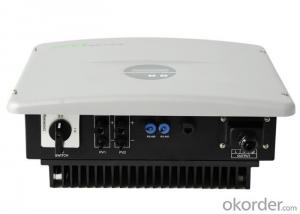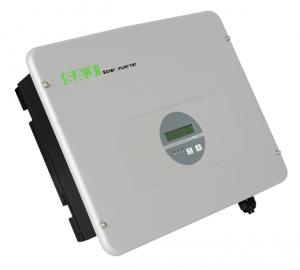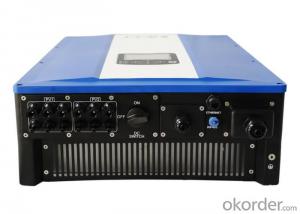On Grid Solar Inverter Sununo-TL3KB 1MPPT
- Loading Port:
- Guangzhou
- Payment Terms:
- TT or LC
- Min Order Qty:
- 28 unit
- Supply Capability:
- 5000 unit/month
OKorder Service Pledge
OKorder Financial Service
You Might Also Like
Product Advantages:
1.Flexible
• Ethernet / Wi-Fi communication
• Wide range of DC input voltage
• IP65 for indoor and outdoor use
2.Reliable
• Comprehensive protection functions
• Compact design, fanless
• First-class components
3.Efficient
• Max. efficiency up to 97.7%
• Euro. efficiency up to 97.1%
• MPPT accuracy up to 99.9%
4. Certificates:
TUV,SAA,G83,ISO9001,ISO14001,etc.
Futures
■ Super junction MOSFET integrated with 97.7% Max. efficiency.
■ Wide MPPT voltage range and low minimum MPPT voltage for flexible configuration.
■ Transformerless design for lower cost and compact size.
■ IP65 and fan-less for longer-term reliability.
■ Ethernet/ Wi-Fi communication interface.
■ Integrated Web Server for local and internet monitoring.
■ Support SAJ Web Portal Monitoring Solutions.
Specifications
Model | Sununo-TL3KB | Sununo-TL4KB |
Max. DC power [W] | 3400 | 4500 |
Max. DC voltage [V] | 580 | 580 |
MPPT DC voltage Range [V] | 120-500 | 120-500 |
Nominal DC voltage [V] | 360 | 360 |
start voltage [V] | 150 | 150 |
Min.DC voltage [V] | 100 | 100 |
Max.DC input current [A] | 17 | 20 |
Number of MPPT | 1 | 1 |
string per MPPT | 2 | 2 |
DC switch | optional | optional |
Images
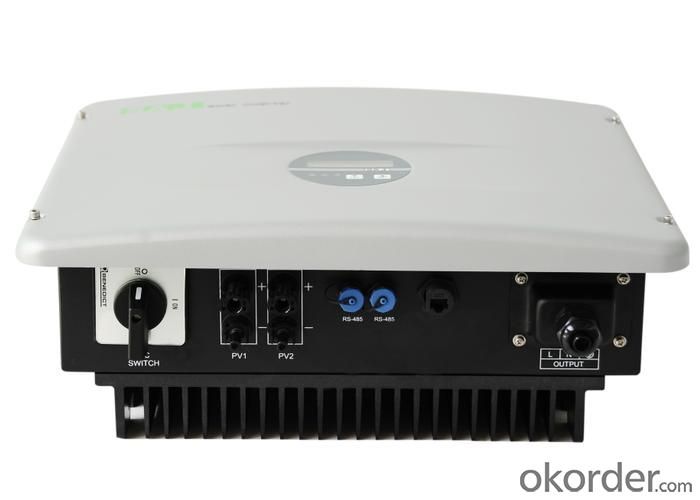
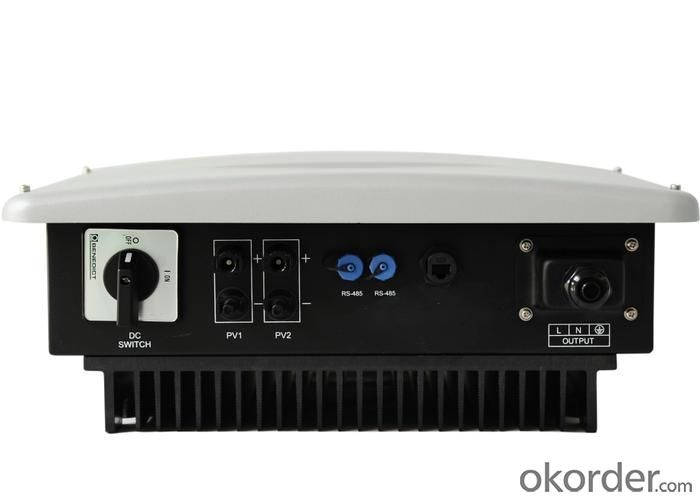
FAQ
1. How long will my inquiry get response?
Your inquiry related to our products or prices will be replied within 24 hours.
2. Can I get professional service and suggestion?
Well-trained and experienced staffs to answer all your questions in fluent English.
3. Do you accept OEM or customized design?
OEM & ODM, any your customized lightings we can help you to design and put into product.
4. What if I need specific design?
Distributorship are offered for your unique design and some our current models.
- Q:What are the different types of solar inverters?
- There are three main types of solar inverters: string inverters, microinverters, and power optimizers. String inverters are the most common and cost-effective option, where multiple solar panels are connected in a series and the inverter converts the DC power from the panels into AC power for use in the home. Microinverters are installed on each individual solar panel, converting DC power to AC power directly at the panel level. Power optimizers are installed with string inverters and optimize the output of each solar panel individually, ensuring maximum energy production.
- Q:Can a solar inverter be used with a string inverter system?
- No, a solar inverter cannot be used with a string inverter system. Solar inverters and string inverters are two different types of inverters that serve different functions in a solar power system. A solar inverter is designed to convert the DC power generated by solar panels into AC power for use in homes or businesses. On the other hand, a string inverter is used to convert the DC power generated by multiple solar panels connected in series, known as a string, into AC power. Therefore, these two types of inverters are not compatible with each other.
- Q:What is the role of a solar inverter in voltage and frequency regulation during islanding conditions?
- The role of a solar inverter in voltage and frequency regulation during islanding conditions is to ensure stability and balance in the electrical system. It actively monitors and adjusts the voltage and frequency levels to match the required standards, even when disconnected from the main power grid. This prevents overvoltage or undervoltage situations and keeps the frequency within acceptable limits, thereby maintaining a reliable and safe power supply in islanded conditions.
- Q:Can a solar inverter be used with a solar-powered waste management system?
- Yes, a solar inverter can be used with a solar-powered waste management system. A solar inverter is responsible for converting the direct current (DC) produced by solar panels into alternating current (AC) that can be used to power various appliances and systems. In the case of a solar-powered waste management system, the solar inverter would ensure that the electricity generated by the solar panels is compatible with the system's components, such as motors, sensors, and controls. This would enable the waste management system to operate efficiently using clean and renewable solar energy.
- Q:Can a solar inverter be used with a solar-powered irrigation system?
- Yes, a solar inverter can be used with a solar-powered irrigation system. The solar inverter is responsible for converting the DC power generated by the solar panels into AC power, which can then be utilized to power the irrigation system. This allows for efficient and sustainable water distribution in agricultural fields through the use of solar energy.
- Q:How does a solar inverter handle voltage dip and interruption?
- A solar inverter handles voltage dip and interruption by monitoring the grid voltage constantly. When it detects a dip in voltage or an interruption, it quickly switches to an internal power source, such as a battery or capacitors, to keep supplying power to the connected solar panels or loads. This ensures a smooth and uninterrupted power supply even during voltage fluctuations or grid outages.
- Q:What is the difference between a string inverter and a microinverter?
- A string inverter is a central inverter that converts the DC power generated by multiple solar panels connected in series into AC power. On the other hand, a microinverter is a smaller inverter that is attached to each individual solar panel, converting the DC power generated by each panel into AC power. The main difference is that string inverters are used for multiple panels, while microinverters are used for individual panels.
- Q:Generally a large grid-connected photovoltaic power plant will have several inverters
- Group is the use of a number of grid-connected inverter and grid-connected AC power grid, the advantage is the loss of small, low cost of the cable (because the PV cable is more expensive), eliminating the cost of the convergence box, and multiple
- Q:Can a solar inverter be used in areas with high altitude and low temperature conditions?
- Areas with high altitude and low temperature conditions can indeed use a solar inverter. However, it is important to take certain factors into account when choosing one for such conditions. The efficiency of a solar inverter can be affected by high altitude, as the reduced air density and oxygen levels can lead to a decrease in power output from the solar panels. Therefore, it is vital to select an inverter that is specifically designed to function at high altitudes. These inverters come equipped with features like advanced cooling systems and improved power electronics to ensure optimal performance in such environments. Similarly, low temperature conditions can also impact the efficiency of a solar inverter. Cold temperatures can negatively affect the internal components of the inverter and overall performance. To overcome this challenge, it is recommended to choose an inverter that is designed to operate in low-temperature environments. These inverters typically include features such as internal heaters and temperature sensors to maintain optimal performance even in freezing temperatures. Furthermore, it is advisable to seek guidance from a professional solar installer or manufacturer who can assist in selecting the most suitable solar inverter for high altitude and low-temperature conditions. They can consider factors like local climate, altitude, and specific installation requirements to ensure that the system is designed to withstand and perform optimally in these demanding conditions.
- Q:Can a solar inverter be used in remote areas without access to the grid?
- Yes, a solar inverter can be used in remote areas without access to the grid. Solar inverters are designed to convert the direct current (DC) electricity generated by solar panels into alternating current (AC) electricity that can be used to power electrical devices. In remote areas, solar inverters can be used to harness the energy from the sun and provide a reliable and sustainable source of electricity, without the need for a connection to the grid.
1. Manufacturer Overview |
|
|---|---|
| Location | |
| Year Established | |
| Annual Output Value | |
| Main Markets | |
| Company Certifications | |
2. Manufacturer Certificates |
|
|---|---|
| a) Certification Name | |
| Range | |
| Reference | |
| Validity Period | |
3. Manufacturer Capability |
|
|---|---|
| a)Trade Capacity | |
| Nearest Port | |
| Export Percentage | |
| No.of Employees in Trade Department | |
| Language Spoken: | |
| b)Factory Information | |
| Factory Size: | |
| No. of Production Lines | |
| Contract Manufacturing | |
| Product Price Range | |
Send your message to us
On Grid Solar Inverter Sununo-TL3KB 1MPPT
- Loading Port:
- Guangzhou
- Payment Terms:
- TT or LC
- Min Order Qty:
- 28 unit
- Supply Capability:
- 5000 unit/month
OKorder Service Pledge
OKorder Financial Service
Similar products
New products
Hot products
Hot Searches
Related keywords

